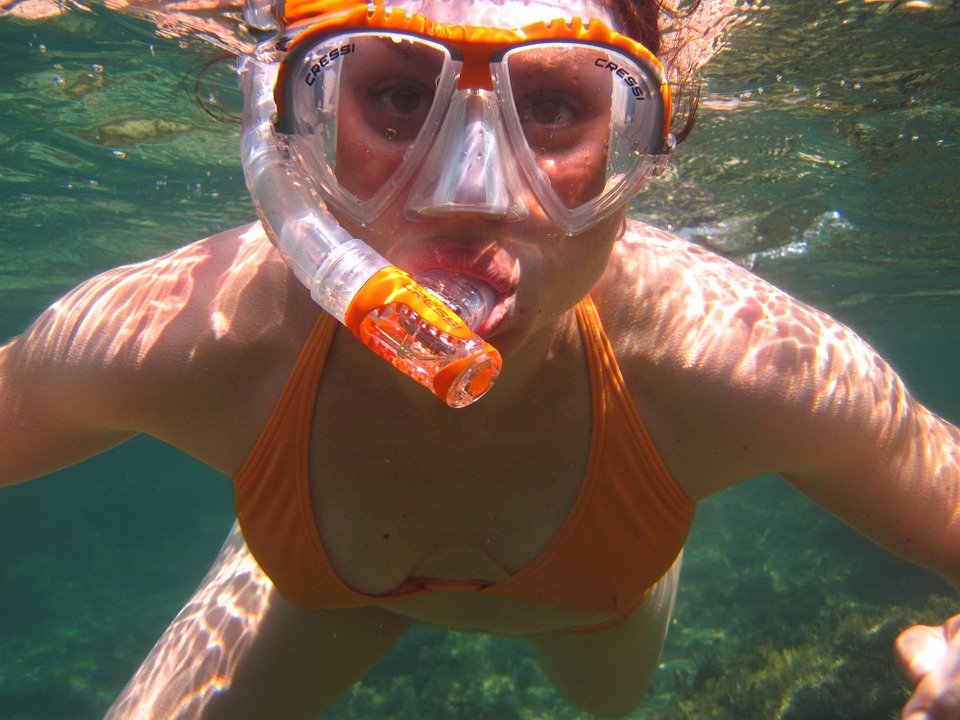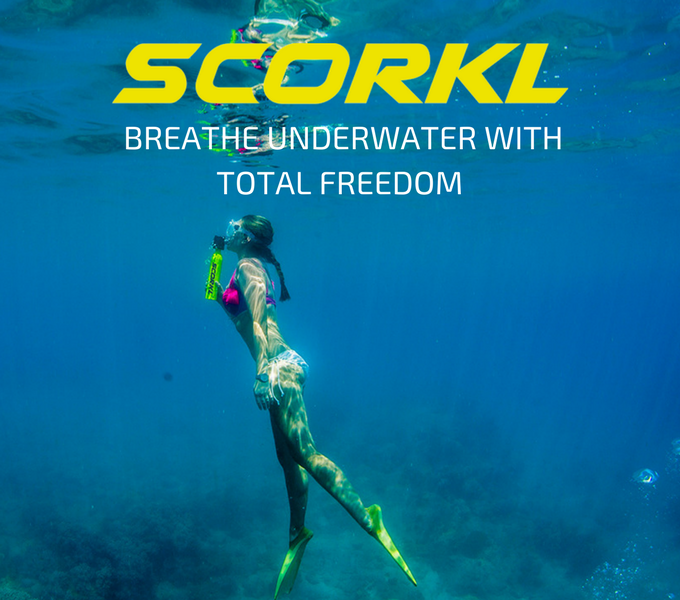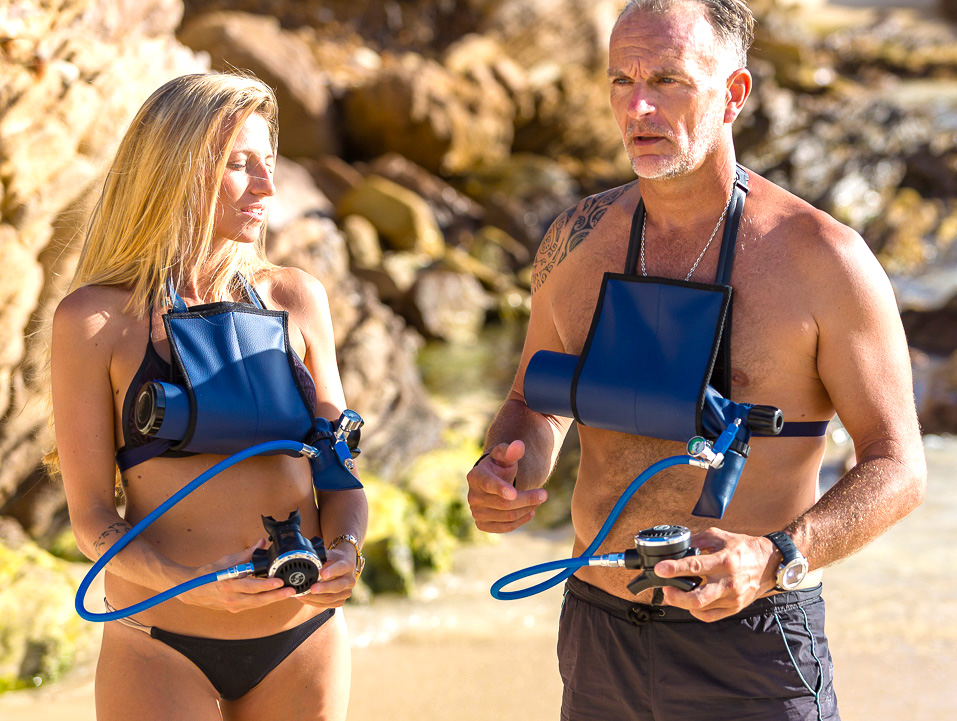Snorkeling is a fun activity that many people love doing – and not just on vacations or holidays. Fact is, snorkeling has fast become more and more popular with the advent of travel blogging and Instagram. A lot of attention has been drawn to vacation destinations that offer ways for you to see the amazing marine life underneath the surface of crystal blue or turquoise waters. As snorkeling grew more popular, more people began innovating – and so new equipment and new methods were born.
One of the things that have started popping up are mini air tanks for snorkeling. But are these little tanks actually a good idea? Or are they risky to use and completely dangerous?
The nature of snorkeling means that you will be under water a lot. In fact, you will be spending enough time underwater that you will actually require a way to breathe for you to truly enjoy this activity. After all, how fun would this be if you could only hold your breath 15 seconds at a time as you look underwater? How much of the marine life would you really be able to see in short bursts without you starting to feel as though you are drowning? How comfortable can you really be looking at the underwater sea life without some sort of breathing tube?
Today, we will be taking a look at tiny air tanks for snorkeling and whether they are good and safe for use. We will be taking a look at different sources and opinions so that we can come to an unbiased conclusion. Are you ready? Let’s get started.
What Are Mini Air Tanks for Snorkeling?

These air tanks for snorkeling are exactly what you might imagine them to be – small air tanks that are light in weight. They contain enough air to give you a serene experience watching the marine life just under the surface. These little air tanks were born from peoples’ desire to have a different way to enjoy snorkeling in general. And while the idea itself is great, the execution still needs some work. As a result, the experience of using snorkeling mini air tanks still has some limitations.
These tiny air tanks work great for watching the sea life when you stay mostly on the surface of the water. With them, you can pretty much keep your head under the water for a rather long time – or at least until the content of the tank runs out. However, to see the marine life that lies farther beneath the surface of the water, you will need to dive deeper. For this, you will have to take a deep breath and see all that the ocean floor has to offer with the limitation of how long you are capable of holding your breath.
One benefit of a mini air tank for snorkeling is that these devices can help you increase at the time that you can spend snorkeling and looking at underwater sea life without you having to undergo actual training for scuba diving. Essentially, the main purpose of this device is to bridge the space in between scuba diving and snorkeling.
Top Mini Air Tanks for Snorkeling Products
There are a few products out there on the market today that have begun popping up. They are often found on crowd sharing websites, where their novelty is rather appreciated and enjoyed. In fact, some of these products become so popular because of viral videos and content that spreads on the Internet about them. Often, these videos are made by social media influencers whose reach can truly get the word out to people who actually want solutions like these.
Today, we will be talking about a couple of the products that have become more popular on the Internet recently. We will take a closer look at them to see their features, what makes them good, and what might not be all that good about them.
The Scorkl

The first and most popular product in the category of mini air tanks is the Scorkl. The Scorkl is actually so very popular on the website Kickstarter that has raised almost 1.3 million Australian dollars – an exponential multiple of its 30,000 Australian dollar goal. This huge amount was raised in one month, from June 2017 to July 2017. As you can see, the fact that this company has raised several times the amount that they were asking for is good proof that people actually want to see a product like this succeeding on the market.
2217 backers have happily given this company their money to support the development of the product. Packages to support Scorkl vary from small amounts such as 10 Australian dollars (or 7 US dollars), going all the way to the highest amount which is 2394 Australian dollars (or 1772 American dollars). Of course, the rewards for each package did vary, depending on the amount pledged.
Features of the Scorkl
The Scorkl is truly one of the first small air tanks for snorkeling that has grown extremely popular. In essence, it is a tiny scuba system that offers a small tank containing air. It has a pressure gauge and comes with a regulator that is “always on”.
It is truly tiny, which means that you can take it wherever you want – it’s relatively easy to throw into your luggage if you are flying out as well (as long as you make sure it is not pressurized and there is no air in the canister during your flight). As a result, many travelers find that they love this product. This is especially true for those who love to spend time beach/island hopping and snorkeling. After all, the Scorkl allows you to spend plenty of time under the surface of the water without the necessity for prolonged and frequent training sessions.
Depth Recommendations and Limitations
This device, though small, will allow you to remain with your face under the water for lengths of up to ten minutes at a time. This range is only achievable in shallow water. The company recommends that you only use the Scorkl in depths of above ten meters to maximize its capacity. However, it can be used up to 20 meters deep, if you are daring enough to swim that far down.
What Makes the Scorkl Different?
Main thing that really excited people who pledged money to this company is the fact that the product is designed in a way where the users can actually refill the tank. One of the features of the product is that it comes with an air pump that is specialized to allow you to refill the air in the tank as often as you deem necessary. Refilling the tank takes about 12 minutes with the use of the special pump. However, if you have a scuba tank handy, refilling can take as little as 30 seconds. Then, you can get right back into the water to see more of what the ocean has to offer.
The regulator of the Scorkl has an “always-on” design. It is manufactured to meet the same standards that a traditional scuba tank would be held up to. You can use this mini air tank without the need to press any buttons or to flip any switches. The pressure gauge is included on the mini tank to allow you to check the remaining air in the device.
Scorkl claims that the size of this product makes it possible for it to offer an experience much more akin to free diving than to scuba diving. The lightweight design allows the user to swim and move much more freely when underwater. Scorkl’s main goal is providing a scuba diving alternative that is not just simple, but also efficient and absolutely safe.
The MiniDive Pro

Another product that falls into the category of snorkeling air tanks is the MiniDive Pro. It was put up on IndieGogo much earlier than the Scorkl – one year ahead in fact. However, it didn’t quite gain as much traction on the website. Still, the MiniDive Pro managed to raise twice the amount it was asking for. One hundred and seventy-six backers raised a total of almost 65,000 pounds. This total is a little more than quadruple the original goal of only fifteen thousand pounds.
Much like the Scorkl, the MiniDive Pro offers you the ability to remain and breathe underwater for about five to ten minutes. It is designed for ease of use – the mini air tank stays in a custom harness designed to go around your neck and chest area. The aluminum tank is so light under the water that you won’t even notice or feel it. Like the above aforementioned product, the MiniDive Pro is also refillable.
The main difference of the MiniDive Pro, however, is the fact that its design is not as sleek and compact as the Scorkl.
Main Stats of the MiniDive Pro
- 3000 PSI working pressure
- 100 Liter Tank Volume
- 4.8 pounds in weight
- Safety recommendation depth: 3 meters for non-divers
- Best for ages eight and above
Refilling the MiniDive Pro
To refill this air tank, there are 4 different options or methods. First, you can use a special hand pump that is designed to be high pressure – this pump is provided by the makers of the product. Second, you can use an electric compressor. Third, you can refill the MiniDive Pro with the use of a normal scuba tank plus an adapter. Finally, the last method is using one of the traditional diving compressors that are normally found in the dive shops.
The best part about this product is the fact that you can simply unscrew an empty tank and screw in a new, full tank for a smoother and easier scuba experience. Therefore, you can prepare a few of these beforehand to take with you to the beach so that you don’t need to stop and refill every 5 to 10 minutes. If you have many tanks, you can then extend the amount of time that you can breathe under the water during every snorkeling trip.
Safety Concerns of Mini Air Tanks
Of course, air tanks for snorkeling have come to change the game. The ability to breathe underwater and to even dive down a few feet without worrying about your snorkel is one that is appreciated by many. However, there are understandably some safety concerns with their design and use.
First of all, this type of product is usually only really recommended to people who consider themselves good and confident swimmers. If you aren’t comfortable in open water, you may want to use a traditional snorkeling mask set instead. Second, if you are not very familiar with this type of equipment, you really have to read all of the safety recommendations and instructions. Reading is not enough – these guidelines must then be followed to a T to make sure that everything goes smoothly.
Also, the deeper you go below the surface of the water, the higher the risk to you. Therefore, you must know and understand how air tanks and air capacities work the further down you go. You must pay attention to the remaining air in your tank and adjust your time underwater accordingly. The last thing you want is to be 10, maybe 20 meters under the water and run out of air before you can swim out to the surface!
What the Diving Community Has to Say
Of course, it is important to see what the diving community has to say about these products. Do scuba divers laud these products as a great way to bridge snorkeling with scuba diving? Or do they find these devices to be unsafe and bad in design?
Well, here are some of the opinions on the Internet, based on an article by Dive Magazine.
Risk of Loss
Scorkl has no way for you to prevent its loss. If a strong wave or current over comes you, or if you accidentally hit something underwater, you lose your air supply and you’re in huge trouble.
Risk of People Not Reading the Full Safety Guidelines
Some of the safety guidelines included on these devices are buried within pages and pages of the manual. For example, a requirement to never stop breathing while ascending or descending is buried all the way to the SIXTH page of one of the manuals. If breath is held during ascent or descent, it can result in lung injuries – it’s truly surprising that this bit of information is hidden all the way to the 6th page.
Depth Gauges and Air Capacity
No depth gauges are included on either product, which makes it difficult to follow safety recommendations. Both products also only recommend use for up to 3m deep for those who are not experienced or certified scuba divers.
Most of the public do not understand how air tanks work underwater, and how capacities are calculated. As such, it is easy for the common user to overestimate the actual amount of air they have to breathe. In fact, if the tank is taken to a depth of 10 meters, the breathing capacity is reduced to as low as 1min 40s!
Other Concerns
Many other concerns are noted on the article. However, the main consensus from the divers is: the device is good for those who know how they work. Their need, however, is not fully understood – because 5-10 minutes of capacity hardly gives you much time to do anything under the water. For people who aren’t familiar with how air behaves in tanks underwater, this device is not recommended. It’s also not recommended to people who are not comfortable with swimming in the open water.
Most divers expressed their opinion that such devices are death traps and liabilities. Some even say they are “lawsuits waiting to happen”. The Scorkl, for example, can easily get lost because the only thing securing it to you is your mouth.
Conclusion
Small air tanks for snorkeling are a novel idea, for sure. However, their need in the market is still in question. The safety of these devices is called into question as well, especially since they are marketed to the lay man who knows nothing about diving. The fact that they are touted as alternatives to scuba training and diving is also rather concerning. Nevertheless, in cases where people actually know how to safely operate them, they can be rather useful and fun.
In the end, if you plan on trying on of these devices, it’s best to make sure you read all of the instructions clearly. Also, make sure that you follow all the safety guidelines exactly. And finally, remember to use this device at your own risk. Know and remember its (and your) limitations, and you should be able to enjoy your snorkeling sessions greatly!
